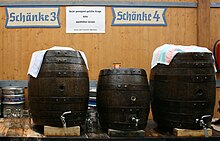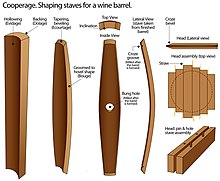Barrel
The word vat is often used for large containers for liquids, usually alcoholic beverages;[3] a small barrel or cask is known as a keg.They are also employed to hold maturing beverages such as wine, cognac, armagnac, sherry, port, whiskey, beer, arrack, and sake.Other commodities once stored in wooden casks include gunpowder, meat, fish, paint, honey, nails, and tallow.For example, in the UK and Ireland, a barrel of beer refers to a quantity of 36 imperial gallons (160 L; 43 US gal), and is distinguished from other unit measurements, such as firkins, hogsheads, and kilderkins.[8] Another Egyptian tomb painting dating to 1900 BC shows a cooper and tubs made of staves in use at the grape harvest.[9] Herodotus (c. 484 – c. 425 BC) allegedly reports the use of "palm-wood casks" in ancient Babylon, but some modern scholarship disputes this interpretation.[11] A lake village near Glastonbury dating to the late Iron Age has yielded one complete tub and a number of wooden staves.The Roman historian Pliny the Elder (died 79 AD) reported that cooperage in Europe originated with the Gauls in Alpine villages who stored their beverages in wooden casks bound with hoops.The Greek geographer Strabo (c. 64 BC to c. 24 AD) recorded that wooden pithoi (barrels or wine-jars) were lined with pitch to stop leakage and preserve the wine.Julius Caesar (100 to 44 BC) used catapults to hurl burning barrels of tar into besieged towns to start fires.The presence of these compounds depends on many factors, including the place of origin, how the staves were cut and dried, and the degree of "toast" applied during manufacture.Some wines are fermented "on barrel", as opposed to in a neutral container like steel or wine-grade HDPE (high-density polyethylene) tanks.Other wooden cooperage for storing wine or spirits range from smaller barriques to huge casks, with either elliptical or round heads.[18] International laws require any whisky bearing the label "Scotch" to be distilled and matured in Scotland for a minimum of three years and one day in oak casks.The pepper mash used to make Tabasco sauce is aged for three years in previously used oak whiskey barrels since its invention in 1868.[24][25] Vernors ginger ale is marketed as having a "barrel-aged" flavor, and the syrup used to produce the beverage was originally aged in oak barrels when first manufactured in the 19th century.The standard size barrel of crude oil or other petroleum product (abbreviated bbl) is 42 US gallons (35.0 imp gal; 159.0 L).Each barrel is refined into about 20 US gallons (17 imp gal; 76 L) of gasoline,[30] the rest becoming other products such as jet fuel and heating oil, using fractional distillation.This facilitates rolling a well-built wooden barrel on its side and allows the roller to change directions with little friction, compared to a cylinder.Traditionally, a barrel is 196 pounds (89 kg) of flour (wheat or rye), with other substances such as pork subject to more local variation.
















Barrel (unit)Gun barrelBarrel (disambiguation)Cask (disambiguation)MackmyraHäckeberga CastleCastle RockmicrobreweryNottinghamEnglandCroatiacylindricalstavescognacarmagnacsherrywhiskeyarrackgunpowdertallowQuercus roburQuercus petraeaQuercus albaQuercus crispulaQuercus garryanacooperaluminumstainless steeltypes of plasticstandard size of measurehogsheadskilderkinsgeneric termEgyptian wall-paintingHesy-RaHerodotusBabylonGlastonburyIron AgePliny the ElderStrabopithoiJulius Caesarcatapultspontoon bridgesScheveningenSilchesterPyrenean silver firAnglo-Saxongrave goodsMercier1889 world expositionage winedistilled spiritsbrandytabasco saucetraditional balsamic vinegaroxygenmicrooxygenationalcoholevaporationhumidityvin jaunevanillintanninschestnutredwoodJapanese cedarearthenwareellipticalwineryBulk winesoak chipsSherry barrelsolerawhite oakbourbon whiskeystraight whiskeycorn whiskeyScotchScotlandCanadian whiskieshogsheadForest of TronçaistequilaBarrel-aged beerOktoberfestCask alesour beersVernorsginger aleThe Angels' ShareBaudoinia compniacensisdistilled spiritvolumerainwaterrainwater harvestingrainwater barrel or water buttrain pipeDrum (container)whale oilage of sailsperm whale oilOlive oilseed oilsbarrelcrude oilpetroleumUS gallonsimp galPennsylvaniaoil fieldsoil tankersgasolinefractional distillationrollingcylinderstressshiveskeystoneswithiesbung holesiliconeEnglish wine cask unitsimperialwine gallon